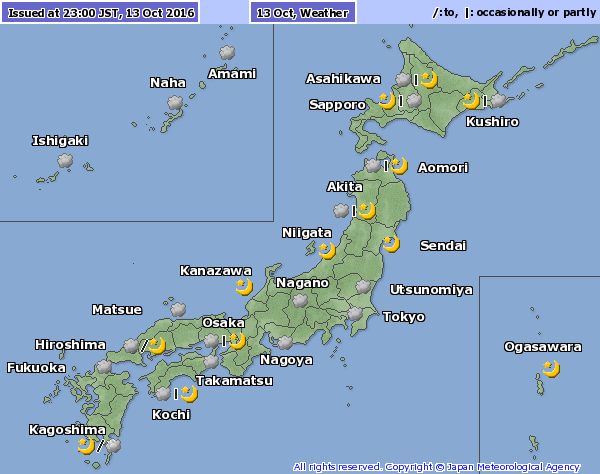In Japan, the citizens commonly
run their activity based on the weather forecast. It's because, Japan is well known
with the precise weather forecast and all the citizen of Japan are believe in it. So that the weather forecast, including the
system and the device, are very important to all the Japanese people. The Automated
Meteorological Data Acquisition System (AMeDAS) is a collection of Automatic
Weather Stations (AWSs) run by JMA (Japan Meteorological Agency) is the device
for automatic observation weather aspects to support realtime monitoring of
weather conditions with high temporal and spatial resolution. An AMeDAS
observing station measuring precipitation, wind direction/speed, temperature
and sunshine duration (with snow cover meter). JMA began operating the AMeDAS
system, which now currently spreaded all around Japan at average intervals of
17 km nationwide, on 1st November 1974.
AMeDAS station
Around 840 stations are installed
to observe wind direction/speed and sunshine duration in addition to
precipitation, and snow depth is observed at about 320 manned and unmanned
stations in snowy districts. In total, there are over 1300 stations are working
throughout Japan. These hourly data from all the stations are acquired to the
AMeDAS center in Tokyo. Together with other observation data, such as
meteorological satellite and radar, AMeDAS data is used to support tailored
forecast and warning to mitigate meteorological disasters. AMeDAS data play an
important role in reducing the risk of weather related disasters. And archived
historical data and statistics are meet the basic information for wide area of
human activities such as decision making, industrial production planning and
farming schedule.
To gain the information about
AMeDAS, especially for the foreigner that didn’t understand Japanese are quite
easy and much enough. The website like http://www.jma.go.jp/, as the official website of Japan
Meteorological Agency, provide information like the overview of AMeDAS, the
detailed picture of AMeDAS station device (as shown above), the full list of
the observation sites, observation element of the AMeDAS complete with the
descrtiption and the unit, examples of AMeDAS data and how to read it, and
AMeDAS observation network all in english. Another website like http://data.sokki.jmbsc.or.jp/ also
add the other information about the difference of hourly data and daily data
gained from AMeDAS. The common website like http://en.wikipedia.org/
even have the page explained the short overview about AMeDAS that enough for
the foreigner that is want to know about AMeDAS.
AMeDAS data showing sample
For gain the weather forecast
information straight from AMeDAS by JMA,
i also try to download the weather forecast application in smartphone from
appstore (by searching with the ‘amedas’ keyword). The application can be
downloaded for free, but for the foreigner the application it quite too
confusing because it is in Japanese. The map for the weather forecast can be
read, but the explanation and the other this are all in Japanese. So it’s
better to install another weather forecast application that run in English and
more simple and easy to understand.
The
weather forecast application from AMeDAS data by JMA
Different
with Japan, the Indonesian forecasting system is not too important for the
daily basis. Because sometimes it’s not precise, so it’s don’t work if we
decide our kind of activity for that day based on the weather forecast. The
system of Indonesian forecasting are based on current condition of the weather
aspect for the short term forecast, and based on statistic by seeing the past
data from decades of weather for the long term weather forecast. Indonesia also
using the remote sensing method by seeing the weight line of ITCZ (Inter Tropical
Convergence Zone) and SPCZ (South Pacific Convergence Zone) for the rain
density forecast.
Source:
http://data.sokki.jmbsc.or.jp/cdrom/monthly_report_jma/documents/amedas_e.htm
https://en.wikipedia.org/wiki/Automated_Meteorological_Data_Acquisition_System
http://www.jma.go.jp/en/yoho/214.html (image)
https://en.wikipedia.org/wiki/Automated_Meteorological_Data_Acquisition_System
http://www.jma.go.jp/en/yoho/214.html (image)





Komentar
Posting Komentar
Comments are welcomed! Siapa tahu pertanyaan kamu sudah pernah dijawab, jangan lupa cek dulu pertanyaan yang sering ditanya di Jawaban Pertanyaan Umum/Frequetly Asked Questions (FAQ) ya! Jangan lupa juga centang kotak "notify me"/"beritahu saya" supaya ada notification jika pertanyaannya sudah dijawab. Terimakasih :)